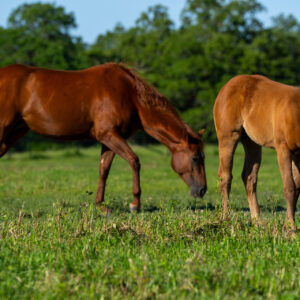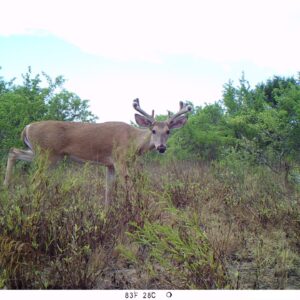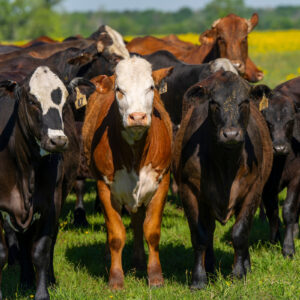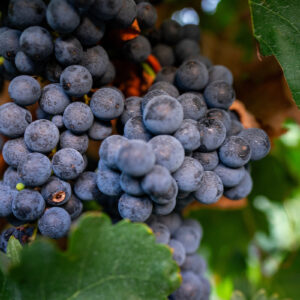Effect of Planting Date and Maturity Group on
Soybean Yield in the Texas South Plains in 2001
Calvin Trostle, Extension Agronomy, Lubbock,(806) 746-6101,
Brent Bean, Extension Agronomy, Amarillo, (806) 359-5401,
Introduction:
Interest continues in soybean production in the Texas South Plains as producers seek alternatives to conventional crops such as wheat, corn, sorghum, and cotton. Soybeans enables the introduction of a legume, favorable in crop rotations, and producers particularly like to plant Roundup Ready soybeans in order to clean up weeds that have become a problem in other crops. Typically soybeans are planted from early May to the first week of July. Planting dates vary depending on how soybeans are being utilized by the producer. Some producers are planting early with the hopes of producing high yield, while others are trying to produce a second crop after wheat harvest or, in the Texas South Plains, seeding soybeans as a catch crop after failed cotton. A question that is often asked is which maturity group of soybeans should be planted on a given planting date? This study is the second year of a three year experiment to answer this.
Companion Report for the Texas Panhandle:
Consult Brent Bean’s report for the third and final year of the companion location near Etter, Moore Co., in the Texas Panhandle.
Methods and Materials:
Studies were located at Texas Agricultural Research Stations at Halfway, TX, in Hale Co. Six soybean varieties of different maturity groups were selected for planting. Maturity groups represented were mid III, late III, early IV, mid IV, late IV, and mid V. Varieties from a single company (Pioneer Hi-Bred) were used in order to ensure that the criteria for placing varieties in maturity groups would be consistent.Each variety was then planted on five dates beginning in early May and continuing until early July. The study design was a randomized block (three early or three late varieties) and statistical analysis was performed using a two-factor (planting date and maturity group) analysis of variance. By separating the early and later maturity groups we could irrigate or harvest as needed for later maturity soybeans without watering matured varieties. Cultural practices and specifics for each site are listed in table 1. Soil testing was conducted, and all soybean ground received 70 lbs. P2O5/A.
Changes from the 2000 trial include changes in the study’s original group late-III and group V soybeans, which were replaced by new varieties from Pioneer. Also, the trial was planted with a cone planter to ensure accurate seeding rates unaffected by seed size.
| Table 1. 2001 cultural practices and site description for studies conducted at Halfway, TX (near Plainview). | ||
| Cultural Practice, Methods, etc. |
|
TAES-Halfway |
| Soil Type | Pullman clay loam, pH ~7.8, O.M. ~0.5% | |
| Plot size and reps | Randomized within early and late maturity, 13.33’ X 66’, 4 rep | |
| Row Spacing (inches) | 40” | |
| Planter | John Deere MaxEmerge 7100 | |
| Seeding Rate (seed/acre) | 131,000 | |
| Herbicide (product/acre) | Prowl, 1.0 qt/A | |
| Inoculant (product/acre) | LiphaTech Soil Implant, 5.5 lb. in-furrow (also 0X & 2X rates @ 0 & 10 lbs./A for Dates 1 & 3) | |
| Irrigation (furrow) | Planting Date, Total Irrigation (inches.)
May 2 – early, 14.2; late, 16.7 May 17 – early, 13.3, late, 16.5 Jun 4 – early, 13.0, late 16.5 Jun 19, early 12.2, late 14.7 Jul 5 – early 11.5, late 11.5 |
|
| Rainfall (inches/month) | Apr 0.21, May 4.70, Jun 0.20, Jul 0.18, Aug 1.12, Sep 1.13, Oct 0.19 | |
| Harvest Dates (dependent on variety and planting date) | Oct 11, Oct 24, Nov 7-8, Nov 16 | |
Results:
Both soybean maturity and planting date had significant effects on yield in 2001 (Table 2). A significant interaction between varieties and planting data also existed. The greatest average yield, 38.6 bu/acre, was achieved with the early June planting date. Across the season the group V maturity soybean was highest in yield, 40.5 bu/acre, though not significantly higher than the mid- and late-IV. Yields were reduced by the early planting date (in contrast to 2000), and again declined considerably with the early July planting date. Although a cone planter unit was used to ensure that seeding rates were the same across planting dates, plant populations declined significantly at the mid-June planting date and even more so for the July planting date to an average of only 57,000 plants/A (Table 3). Earlier planting dates were about 50% higher, but a correlation of plot yields (excluding the last planting date) indicated that differences in plant population explained on average only 7 to 34% of the yield variation (R-squared) within each planting date. The near record heat in late June and July apparently curtailed stand establishment even though irrigation was used after planting to provide germination moisture.
We again note that the conventional thinking that late planted soybeans should be shorter maturity does not appear to be correct in the Texas South Plains. Not only were yields lower with the earlier maturity soybeans for the mid-June and July plantings, but the short plants contribute to harvest losses (Table 6). Also, in our study we noted that Pioneer Hi-Bred variety 9396, marketed as a late-III, was in fact the shortest maturing in summer 2000. This variety performed poorly at all planting dates in 2001 relative to the other varieties, more so than in 2000.
| Table 2. Planting date and maturity group effect on soybean yield at Halfway, 2001. | |||||||
|
Variety (Pioneer) |
Maturity Group |
Planting Date1) |
Average2) |
||||
|
May 2 |
May 17 |
June 4 |
June 17 |
July 5 |
|
||
|
—————————– Yield, bu/acre ——————————- |
|||||||
|
93B53 |
Mid III |
20.5 l |
26.6 h-k |
36.7 c-f |
35.2 d-g |
18.4 l |
27.5 B |
|
9396 |
Late III |
14.7 l |
21.6 l |
28.9 f-i |
20.7 l |
17.1 l |
20.6 C |
|
94B01 |
Early IV |
26.9 h-j |
27.9 g-i |
38.5 c-e |
31.4 e-h |
21.7 l |
29.6 B |
|
94B81 |
Mid IV |
38.1 c-e |
38.1 c-e |
40.9 a-d |
36.7 c-f |
27.5 g-j |
36.2 A |
|
9492 |
Late IV |
40.2 a-d |
41.2 a-d |
39.5 b-e |
39.0 b-e |
26.2 h-k |
37.2 A |
|
95B53 |
Mid V |
38.4 c-d |
47.8 a |
47.1 a-b |
43.6 a-c |
25.7 h-k |
40.5 A |
|
|
|
|
|
|
|
|
|
|
Average2) |
|
29.8 A |
33.8 AB |
38.6 A |
34.4 AB |
22.8 C |
31.9 |
| 1) Yield of each variety at each planting date followed by the same small letter are not significantly different according to ANOVA at P = 0.05.
2) Average yield of each variety or average yield of each planting date followed by the same capital letter are not significantly different according to ANOVA at P = 0.05. |
|||||||
Soybeans had not been grown on the field for at least 10 years. Under these circumstances one might expect a low potential for Rhizobium nodulation from native soil strains of Rhizobium. We have learned from our experience with black-eyed peas and peanuts in the South Plains that Rhizobium nodulation may not be taken for granted. Most soybean growers in the Plainview area do not inoculate their soybeans with Rhizobium. Is this practice detrimental to crop yield? As in 2000 to test this, we also instituted at Dates 1 and 3 a Rhizobium inoculant trial using granular Soil Implant inoculant for soybean from Liphatech (formerly Nitragin). Replicated nodule counts were performed (Table 4) and yields were measured at 0X, 1X (standard rate of 5.0 lbs./acre), and 2X inoculation rates (Table 5). Rhizobium nodulation from native soil microbes was less than 2 nodules per plant whereas inoculation at the 1X rate increased nodule number somewhat. Nodulation was further increased with a 2X rate to over 10 per plant. This is not considered good nodulation. We believe the heat manifesting itself in hot soil temperatures may have curtailed nodulation. Nodule counts at the south end of the test area, where water ponded averaged 11.7 nodules/plant for the 1X rate whereas on the north end of the field the average was about 4. Yields on the south end, however, were only slightly higher regardless of Rhizobium treatment. The increase in yield at the early May planting date was 4.4 bu/A but not statistically significant.
Comparison to first-year results at Halfway in 2000. In spite of hotter weather and similar water, the overall test yield average in 2001 (31.9 bu/A) was slightly higher than in 2000 (29.7 bu/A). The yield increase could be in part due to the application of P fertilizer. In 2001, longer season soybeans were the better choice than in 2000, particularly at the late planting date. Hot weather stress may have limited the earlier planting dates in 2001 as top yields were achieved with the mid-May through mid-June plantings. In 2000, the yields were typically highest at the first planting date. Rhizobium nodulation averaged in the mid-20s in 2000, but was lower by about ½ to 2/3 in 2001 at the 1X rate although the same product was used.
|
Table 3. Plant populations of different maturity soybeans across five planting dates at Halfway, 2001.
|
|||||||
|
Variety (Pioneer) |
Maturity Group |
Planting Date |
Average1) |
||||
|
May 2 |
May 17 |
June 4 |
June 17 |
July 5 |
|
||
|
—————————– Yield, bu/acre ——————————- |
|||||||
|
93B53 |
Mid III |
82900 |
87600 |
93400 |
76100 |
61400 |
80300 A |
|
9396 |
Late III |
91300 |
91100 |
89100 |
69600 |
53100 |
78800 A |
|
94B01 |
Early IV |
90800 |
84400 |
104300 |
76600 |
49400 |
81100 A |
|
94B81 |
Mid IV |
92300 |
86500 |
90100 |
75100 |
60500 |
80900 A |
|
9492 |
Late IV |
96600 |
87400 |
84000 |
77300 |
61100 |
81300 A |
|
95B53 |
Mid V |
81800 |
91900 |
76900 |
70400 |
57300 |
77500 A |
|
|
|
|
|
|
|
|
|
|
Average1) |
|
90300 A |
88700 A |
89600 A |
74200 B |
57100 C |
80000 |
| 1) Average plant population of each variety or average plant population of each planting date followed by the same capital letter are not significantly different according to ANOVA at P = 0.05. | |||||||
| Table 4. Average Rhizobium nodule numbers per plant of mid-IV maturity soybeans at Halfway, 2001. | ||||||
|
Inoculant Factor |
Inoculant Rate |
Planting Date1) |
||||
| (lbs./acre) |
May 2 |
May 17 |
June 4 |
June 17 |
July 5 |
|
| ———— Average Rhizobium nodules/plant ——— | ||||||
|
0X |
0 |
1.1 d |
|
0.5 d |
|
|
|
1X |
5.0 |
7.4 b |
4.1 c |
7.0 b |
4.1 c |
3.6 c |
|
2X |
10.0 |
10.6 a |
|
12.5 a |
|
|
1) Nodule number followed by the same small letter are not significantly different according to ANOVA at P = 0.05.
| Table 5. Rhizobium inoculation rate effect on mid-IV soybean yield for two dates at Halfway, 2001. | |||||||
|
Inoculant Factor |
Inoculant Rate |
Planting Date1) |
|
||||
| (lbs./acre) |
May 2 |
|
June 4 |
|
|
|
|
| ——— Yield, bu/acre ——— | |||||||
|
0X |
0 |
33.7 b |
|
39.8 a |
|
|
|
|
1X |
5.0 |
38.1 a |
|
40.8 a |
|
|
|
|
2X |
10.0 |
38.7 a |
|
38.5 a |
|
|
|
| 1) Yield of each Rhizobium treatment at each planting date followed by the same small letter are not significantly different according to ANOVA at P = 0.05.
|
|||||||
| Table 6. Height of different soybean maturity groups planted across five planting dates at Halfway, 2001. | ||||||
|
Variety (Pioneer) |
Maturity Group |
Planting Date1) |
||||
|
May 2 |
May 17 |
June 4 |
June 17 |
July 5 |
||
| —————— Plant Height (inches) ——————- | ||||||
|
93B53 |
Mid III |
16.8 |
17.8 |
18.3 |
18.0 |
15.5 |
|
9396 |
Late III |
16.8 |
21.8 |
21.5 |
18.3 |
20.5 |
|
94B01 |
Early IV |
18.0 |
22.0 |
25.5 |
23.0 |
21.5 |
|
94B81 |
Mid IV |
24.3 |
27.5 |
28.8 |
28.0 |
27.3 |
|
9492 |
Late IV |
22.3 |
22.8 |
23.5 |
22.8 |
21.0 |
|
95B53 |
Mid V |
25.5 |
27.0 |
31.3 |
26.0 |
27.0 |
Funding:
This study was funded by the Texas Soybean Producers Board.





